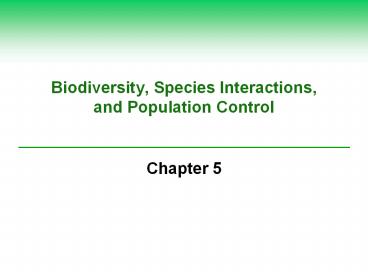Biodiversity, Species Interactions, and Population Control - PowerPoint PPT Presentation
Title:
Biodiversity, Species Interactions, and Population Control
Description:
Biodiversity, Species Interactions, and Population Control Chapter 5 * 5-1 How Do Species Interact? Concept 5-1 Five types of species interactions competition ... – PowerPoint PPT presentation
Number of Views:158
Avg rating:3.0/5.0
Title: Biodiversity, Species Interactions, and Population Control
1
Biodiversity, Species Interactions, and
Population Control
- Chapter 5
2
5-1 How Do Species Interact?
- Concept 5-1 Five types of species interactions
competition, predation, parasitism, mutualism,
and commensalism affect the resource use and
population sizes of the species in an ecosystem.
3
- Species
- Interactions
4
COMPETITION
- Organisms compete for shared or limited resources
such as food, water, space, and habitats. - Competitive exclusion principle No two species
can occupy the exact same niche for very long - More in Section 5-2
5
COMPETITION
- Interspecific competition is the competition
between member of two different species. The
result is that neither species can obtain as many
resources as they could in the absence of the
other species. - Intraspecific competition is the competition
between member of the same species. - This also includes the competition
for mates.
6
PREDATION
- Species called predators feed on other species
called prey. - Organisms use their senses to locate objects and
their prey. - Some predators are fast enough to catch their
prey, some hide and lie in wait, and some inject
chemicals to paralyze their prey.
7
PREDATION
- Some prey may escape their predators by
- Camouflage
- Outer protection
- Chemical warfare
- Warning coloration
- Mimicry
- Deceptive looks
- Deceptive behavior
8
Predator and Prey Species Can Drive Each Others
Evolution
- Intense natural selection pressures exist between
predator and prey populations - Coevolution changes in the gene pool of one
species can lead to changes in another species - Evolution in the predator population improved
abilities to capture prey - Evolutionary response the prey improves its
abilities to avoid capture - The evolution of improved escape abilities should
result in increased capture abilities. - Evolutionary arms race
- The levels of defense and counter-defense will
continue to escalate.
9
Parasitism
- Parasitism occurs when one species feeds on part
of another organism. - Although parasites can harm their hosts, they can
promote community biodiversity. - Some parasites live inside the host
(micororganisms, tapeworms). - Some parasites live outside the host (fleas,
ticks, mistletoe plants, sea lampreys). - Some have little contact with host (cowbirds
lay eggs in anothers nestlet them take care of
young.)
10
Parasitism
11
Mutualism
- In mutualism, two species interact in a way that
benefits both of them. - Most organisms benefit through mutualistic
interactions by gaining nutrition or protection.
12
Commensalism
- Commensalism is an interaction that benefits one
species but has little, if any, effect on the
other species.
- Epiphytes
13
5-2 How Can Natural Selection Reduce Competition
between Species?
- Concept 5-2 Some species develop adaptations
that allow them to reduce or avoid competition
with other species for resources.
14
5-2 How Can Natural Selection Reduce Competition
between Species?
- Niches (way of life) become separated to avoid
competition for resources. - Reduce niche overlap
- This is also the basis of natural selection the
pressure that drives the evolution of new
species. - Chapter 4
15
5-2 How Can Natural Selection Reduce Competition
between Species?
- Some species evolve adaptations that allow them
to reduce or avoid competition for resources with
other species (resource partitioning). - Each species minimizes competition with the
others for food by spending at least half its
feeding time in a distinct portion of the spruce
tree and by consuming somewhat different insect
species.
16
5-2 How Can Natural Selection Reduce Competition
between Species?
- Genetic variation and specialized feeding niches
can lead to evolutionary divergence. - Use shared resources at different
- Times
- Places
- Ways
- Each species has a beak specialized to take
advantage of certain types of food resource.































